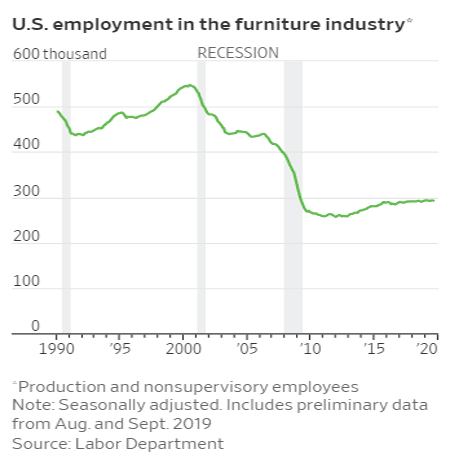The US furniture industry has been generally decimated by imports, especially from China, shedding workers at a rapid pace in the process, down some 250,000 from its peak in 2000.
But now, the Wall Street Journal reports, US furniture makers are mounting a comeback, the result of tariffs on imports but also changing consumer preferences. More and more buyers now want to be able to customize their furniture configurations - but refuse to wait many weeks or months to receive their orders when made offshore.
So now, US production is up, as shown in chart from the Journal below:

Crate & Barrel and Williams-Sonoma are expanding furniture manufacturing in the US, and the factories of longtime furniture makers that have held on are now very busy.
The new threat: not enough workers to meet the available positions in furniture plants and needed to keep the growth going. And upolstered furniture production is very difficult to automate.
Given the devastation the sector has seen, "A generation of prospective sewers and upholsterers have steered clear of the industry, leaving it heavily reliant on an aging workforce,"' the Journal notes. And tens of thousands of industry workers have retired or will reach that age soon.
One answer: The Catawba Valley Furniture Academy in industy hotbed Hickory, NC, created by local companies struggling to find skilled employees in partnership with Catawba Valley Community College.
The probem: The academty can graduate 150 people a year, while Hickory needs 800 to 1,000 people, one furniture company executive there said.
Any Feedback on our Supply Chain Graphic of the Week? What do you think of this contributor list? Let us know your thoughts at the Feedback section below.
Your Comments/Feedback
|